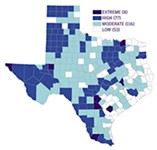How Does TDR Work?
By Katherine Gregor, Fri., Sept. 11, 2009
Of course, TDR works only when there is a market for development rights. Neither the Downtown Austin Alliance nor the Heritage Society is convinced that's currently the case in Austin. On average, ROMA's research has revealed that projects are not even using the 8:1 floor-to-area ratio conveyed by all central business district zoning. To create a market for TDR, and the density bonus program as a whole, ROMA Design Group and HD&R Advisors suggest the city would have to repeal central business district-central urban redevelopment zoning, which allows Downtown property owners to get additional height simply by asking City Council. Even then, Downtown development would have to heat up considerably before there's a hot TDR market.
Portland maintains a TDR database, but requires each owner to find a buyer for his or her available development rights. Seattle (which started its program in 1985) maintains and underwrites a TDR bank. Qualifying owners sell the bank deposits, often to fund historic preservation projects; developers make withdrawals, buying additional square feet needed. For the first 12 years, the city of Seattle served as the sole purchaser of TDRs. (However, it prioritized affordable housing TDRs; only more recently were historic landmark TDRs added to the bank program.) Charlie Betts of the Downtown Austin Alliance has suggested that the security of a city bank could make TDRs more attractive here. But ROMA's Jim Adams believes a TDR bank for Austin is not realistic, noting that "experience with TDR banks has been spotty."
For more background, read Beyond Takings and Givings: Saving Natural Areas, Farmland, and Historic Landmarks With Transfer of Development Rights and Density Transfer Charges, by Rick Pruetz.
Got something to say on the subject? Send a letter to the editor.








